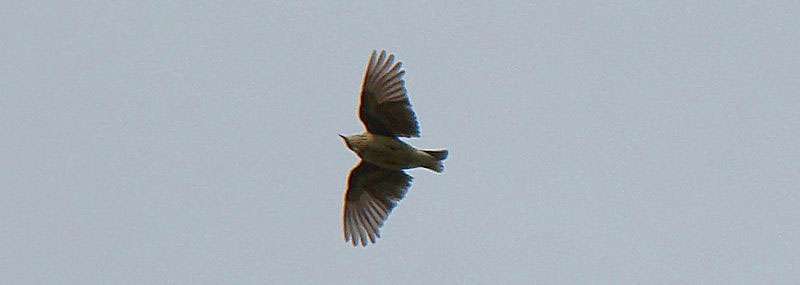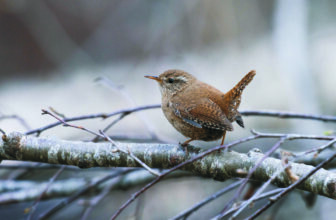
Woodlark Lullula arborea
Lots of people think Spring is truly sprung when they hear the first Cuckoo or see the first Swallow. But for me it is long before then.
The signs that Summer is on its way seem to emerge earlier every year. Blackbirds were singing in the early days of January this year, despite the cold, and by the end of that month Blue Tits and Great Tits were investigating nest boxes.
But for me one bird stands out around here as the harbinger of warmer Spring days to come. It is a very scarce summer visitor to these parts and an irregular breeder. The good news is that over the last 25 years it has been successfully extending its range.
Meet the Woodlark. Probably not a species most people have knowingly seen but it is one they have undoubtedly heard as a background songster in television dramas. The species made regular vocal appearances in BBC 1’s Lark Rise To Candleford series, for instance.
It is not a garden bird and its name is misleading. I have never seen one in a wood and don’t expect to. But if there is a large woodland clearing on Surrey Hills heathland then you may be blessed. The far-carrying song is a cheery and scale-descending ‘titlooet-titlooet-titlooet’ repeated typically from a perch near the top of a Scots Pine or Silver Birch, or somewhere in the sky.
You go all late summer, autumn and winter without hearing one and then suddenly – the melody is back! Just like last year and the one before. After months of virtual silence, the heath seems to spring back into life as the Woodlark renders its fluty notes around Valentine’s Day.
But where is it? The Woodlark is even harder to find than the bigger Skylark.
You gaze up into a blue sky from your Surrey Hills watch point but you cannot see this ventriloquist. One moment he seems to be nearly above you, and then he’s further away. Or is that another one? You keep searching and then you spot a distant speck. It is far above The Shard’s shining pinnacle emerging from the grey London gloom beyond you. Could this most beautiful song be coming so strongly from something so small and high? Yes it could! And there it is, hovering as it sings for minutes on end before gradually descending in a series of bounces. The dot becomes the shape of a giant butterfly before the bird flies away in a series of bounds like a short-tailed dumpy woodpecker.
If you are fortunate to be close you will see it is what some might describe as a drab looking bird. It is mostly streaked brown and white on its upperparts but with a long white stripe (supercilium) above the eye.
Now it may not be one of our best lookers but – as I’ve often found in the birding world – the prettiest may be blessed with good looks but the drabbest attract you from much further away because they are the best singers.

Woodlark Lullula arborea in flight
It is known the Woodlark was present around Pitch Hill in the first half of the 20th century. Lean years followed but then there was a record of a singing bird at one site in 1983 and following habitat management by Hurtwood Control and others the species re-appeared in 1996 and bred in 1997, when four were still present into November. Since then it has just about held its own although it remains one of our rarest birds in and around Cranleigh.
Its apparent drabness stands it in good stead as camouflage because it breeds on the ground on our heaths so is extremely vulnerable from a variety of enemies. A nest with three eggs in 1999 was twice predated, probably by Crows, just a few days before hatching. This is a fate shared by other nests in the area.
The Crows are sentries, watching from a vantage point, for any birds disturbed on the heathland. That is why, if you have a dog, our local conservationists request you kindly keep it to the tracks or put it on a lead particularly between the beginning of April and the end of August when so many ground-nesting species are breeding.
A runaway dog, children, or runners may have a lovely time ploughing through the heather.
They may avoid the well-hidden nests themselves – and the adders – but once they get near a sitting bird they disturb it and off it flies.
And then the Crows know exactly where to go to grab the eggs or nestlings.
Twitter – @Crane_Spotter











